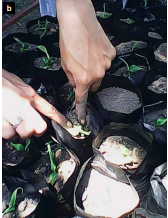Acclimatization of ‘Plátano Hartón’ vitroplants under agroecological management in Yaracuy state
Abstract
The banana, Musa AAB, is a crop of economic and nutritional importance, which is planted throughout the country, being the states with the highest production: Zulia, Trujillo, Mérida, Táchira, Yaracuy, Miranda, Barinas, Apure, Monagas and Delta Amacuro (Navas, 1997).
In Yaracuy state, the production system for this item has been characterized by the use of materials susceptible to pests and diseases; combined with inappropriate agronomic management, which have a considerable impact on obtaining quality seeds in sufficient quantity to recover or start new plantations (Aponte, 2009). Within this context, micropropagation emerges as an alternative for the mass production of seeds, of genetic and phytosanitary quality, to make it available to producers.
In Yaracuy state, the production system for this item has been characterized by the use of materials susceptible to pests and diseases; combined with inappropriate agronomic management, which have a considerable impact on obtaining quality seeds in sufficient quantity to recover or start new plantations (Aponte, 2009).
Within this context, micropropagation emerges as an alternative for the mass production of seeds, of genetic and phytosanitary quality, to make it available to producers.
This technique consists of developing, under laboratory conditions and using nutritive media, a complete plant through the cultivation of an initial explant (cell, tissue or organ). However, this process has its critical point in the acclimatization phase, where the vitroplant has to adapt from conditions of low temperatures, controlled radiation and low atmospheric demand, to an environment of high atmospheric demand, temperature and variable environmental irradiation, which that causes losses that could be around 30% (Institute of Plant Biotechnology, 2005).
References
Cano, A. (2011). Interacción de microorganismos benéficos en plantas: Micorrizas, Trichoderma spp. Y Pseudomonas spp. U.D.C.A Act. & Div. Cient. 14(2):15 - 31, 2011 http://www.scielo.org.co/pdf/rudca/ v14n2/v14n2a03. Revisado el 29 de julio 2015.
Díaz, R., B. Moreno, J. Hernández, G. Blanco, L. Hernández y E. Medina. 2014. Respuesta de vitroplantas de Plátano Hartón a la aplicación de Trichoderma y Lixiviado de plátano. XII Congreso Venezolano de Fruticultura. 2014, Cocorote, Yaracuy, Venezuela. Memorias. Depósito Legal: lf22320146311938. Venezuela.
Fonteno, D. 1999. Sustratos: tipo y propiedades físicas químicas en: agua, sustratos y nutrición. Reed. D., editor y Pizano, M., traductor. Bogota.
Instituto de Biotecnología de las Plantas. 2005. Protocolo para la micropropagación de cultivares de plátanos y bananos mediante organogénesis. Universidad entral “Martha Abreu” de Las Villas. Cuba. Navas, C. 1997. El plátano. Su cultivo en Venezuela. Ediciones Astro Data, S.A. Venezuela.
Moreno, B., J. Hernández, G. Blanco, L. Hernández, R. Díaz, y E. Medina. 2014. Evaluación participativa de vitroplantas de Plátano ‘Hartón’ en aclimatización con el uso de diferentes sustratos y fertilizantes biológicos. XII Congreso Venezolano de Fruticultura 2014, Cocorote, Yaracuy, Venezuela: memorias. Depósito Legal: lf22320146311938. Venezuela.
Segovia, R., A. Bedoya, W. Triviño, H. Ceballos, G. Gálvez y B. Ospina. 2011. Metodología para el endurecimiento masivo de vitroplantas de yuca.Es.slideshare.net/biologiageneral/endurecimiento. Revisado el 30 de julio 2015.


